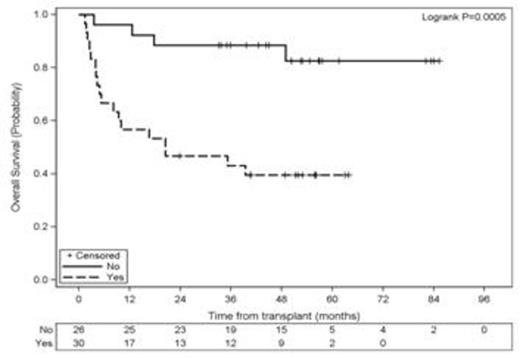Abstract
Allogeneic transplantation for multiple myeloma (mm), although seen as potentially curative, has inherent treatment-related mortality and long-term implications. Important questions remain such as the expectation for long-term survival and the role, if any, of the graft versus tumor effect.
The study cohort included 56 consecutive patients (pts) with mm who received an allogeneic hematopoietic stem cell transplant (HSCT) between November 9, 2004 and June 1st 2011. Only pts who had received at least one prior autologous transplant were included in this retrospective analysis. Patients received either a non-myeloablative (NMA), a reduced intensity (RIC) or an ablative (MA) regimen. The NMA regimen consisted of low dose TBI for siblings and low dose TBI with fludarabine for unrelated donors. The RIC regimen was fludarabine melphalan, with the addition of low dose thymoglobulin for unrelated donors. The MA regimen was busulfan and melphalan, with thymoglobulin for unrelated donors. A favorable group of 26 pts received their allogeneic transplantation for consolidation after demonstrating a response (PR, VGPR, CR) to their prior autograft and without evidence of progression, leaving 30 pts in the salvage transplant group defined as pts unresponsive (less than PR) or with relapse after their prior autograft. The median age was 52.4 years (SD = 6.9 years). Twenty six (46%) pts were female. The hematopoietic cell donors were 35 siblings and 21 unrelated (URD). In the URD group, 10 (47.6%) pts had a mismatched donor. In our cohort 10 (17.9%) pts received a MA, 22 (39.3%) received a RIC and 24 (42.9%) received a NMA regimen. The median follow-up was 52 months. The related and unrelated donor cohorts were similar except for age (53.9 years versus 49.8 years p = 0.03).
Overall survival salvage (yes) vs consolidation group (no)
Overall survival pts with (yes) or without (no) chronic GVHD
Multivariate analysis shows OS significance for being in the salvage group (HR 4.05, p=0.0196), a GVHD (HR 2.99, p=0.034) and cGVHD (HR 0.26, p=0.012), the latter being protective. The PFS for all 56 pts was 38% at 5 years, 57% for the consolidation group and 21% for the salvage group.
In conclusion, patients with multiple myeloma can have an excellent overall survival following allogeneic transplantation even in the setting of relapsed or refractory disease to a prior auto HSCT. Unrelated donors performed just as well as matched siblings. Acute GVHD was deleterious to OS, whereas chronic GVHD was significantly associated with improvement in OS supporting the role of a graft versus tumor effect in multiple myeloma.
No relevant conflicts of interest to declare.
Author notes
Asterisk with author names denotes non-ASH members.



